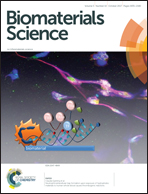Clot-entrapped blood cells in synergy with human mesenchymal stem cells create a pro-angiogenic healing response†
Abstract
Blood clots stop bleeding and provide cell-instructive microenvironments. Still, in vitro models used to study implant performance typically neglect any possible interactions of recruited cells with surface-adhering blood clots. Here we study the interaction and synergies of bone marrow derived human mesenchymal stem cells (hMSCs) with surface-induced blood clots in an in vitro model by fluorescence microscopy, scanning and correlative light and electron microscopy, ELISA assays and zymography. The clinically used alkali-treated rough titanium (Ti) surfaces investigated here are known to enhance blood clotting compared to native Ti and to improve the healing response, but the underlying mechanisms remain elusive. Here we show that the presence of blood clots synergistically increased hMSC proliferation, extracellular matrix (ECM) remodelling and the release of matrix fragments and angiogenic VEGF, but did not increase the osteogenic differentiation of hMSCs. While many biomaterials are nowadays engineered to release pro-angiogenic factors, we show here that clot-entrapped blood cells on conventional materials in synergy with hMSCs are potent producers of pro-angiogenic factors. Our data might thus not only explain why alkali-treatment is beneficial for Ti implant integration, but they suggest that the physiological importance of blood clots to create pro-angiogenic environments on implants has been greatly underestimated. The importance of blood clots might have been missed because the pro-angiogenic functions get activated only upon stimulation by synergistic interactions with the invading cells.



 Please wait while we load your content...
Please wait while we load your content...